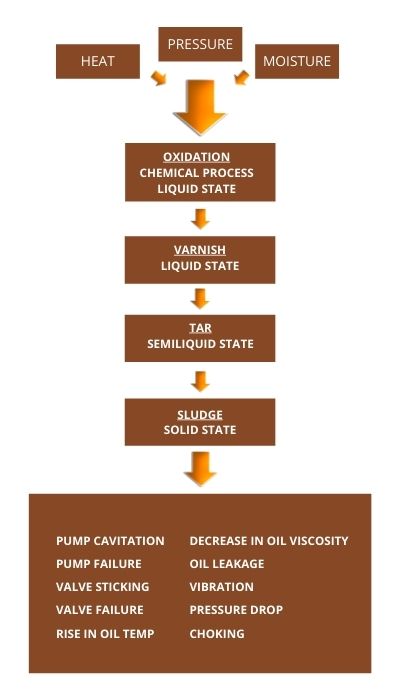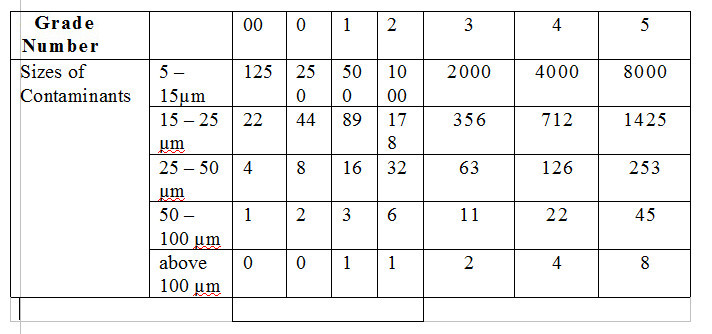
FAQ's
There are two types of contamination
I) Exernal - Exernal is ingress into the hydraulic system from external environmental factor
II) Internal - Internal contamination of oil is a complex process which introduces or creates insoluble or undissolved material in the oil, that will alter the properties of oil and may make it useless for the purpose it is being used. To understand contamination and its build up in a better way, please refer to the diagram below.

NAS class is a standard laid down by NASA which stands for National Aerospace Society of America. For a particular sample of oil, the number of contaminants in a fixed volume (typically, 100 ml) of oil is counted. These contaminants are then classified according to their size in micrometers (µm). The NAS class then represents a particular concentration of contaminants in that volume of oil. The NAS chart below will make this concept clear.
NAS 1638 CONTAMINANTS SPECIFICATIONS ( per 100 ml )


These conventional filters are able to control contamination only at the sludge stage - when it is already too late. EOP system stops contamination at the oxidation stage itself, not allowing contamination to progress from oxidation to varnish to tar to sludge.
First of all, contaminants are already present even in “new” oil. (Please see the NAS chart in Ans.2) New oil vusually NAS 10 to 12 class even this new oil is not good enough for high end hydraulic systems using servo/moog valves. Secondly, even though the system is closed, there are air breathers through which fine atmospheric contamination invariably enters the system? Thirdly, contamination is all the time generated internally in the system through a combination of heat, pressure and moisture (Please refer to the diagram in Ans.1) as well as wear and tear of contacting surfaces such as gears. This is why; oil filtration is always needed, irrespective of your system being closed or open.
Not exactly! Our machine capacities of 10, 25, 50 or 100 litres refer to the volume of the electrostatic cell, through which the oil is circulated. The purification capacity of a machine actually depends upon the initial contamination levels of oil and the viscosity of oil. For example, say - oil has a viscosity of 68 cSt. Within 24 hours, a 50 litre machine can purify about 100 litres of such ‘very dirty’ oil (10 mg of contamination per 100 ml of oil), right upto about 300 litres of similar “new” oil. On an average, within 24 hours, it can clean 200 litres of moderately dirty oil (5 to 7 mg / 100 ml).
The pump capacity has no relation to purification. Pump capacity tells you the flow-rate of oil through the electrostatic cell. (e.g. pump flow rate will be 5 litres per minute for 10 Ltr machine, 10 lpm for 25 Ltr. machine, 15 lpm for 50 Ltr. machine and 20 lpm for 100 Ltr. machine.) As stated earlier, purification depends on quantity of contamination and viscosity of oil. Flow rates may vary according to the pump.
As mentioned earlier, even new oil is not free from contamination. Oil running in the system may also be heavily contaminated. In any system, which is in continuous use, contamination generation is also continuous. Just topping the oil does not remove any contamination contained within the system, or the contamination that would be generated continuously.
No.The advantage of the EOP is that you need not shut down your system to purify the oil. In this sense, this is a parallel process. In fact it is recommended that your system be in operation during purification so that - not only the oil in the reservoir gets purified, but the oil in the entire system gets purified. (It is something akin to dialysis treatment, where you do not stop your heart to have your blood purified).
It has been proven by tests conducted by reputed oil companies like Indian Oil and Castrol that even prolonged usage of an EOP machine does not have an effect on the additives in hydraulic, lubrication and turbine oils. Nowadays all oils have soluble additives and these are not affected by an EOP machine.
An EOP machine is not recommended for usage on engine oils where the main additive is detergent. In fact it is not recommended for any oil having detergent as an additive. This is because detergent is an insoluble additive, which, in small proportions, is removed by an EOP machine – while in large proportions, it leads to the tripping of EOP machine, as the oil becomes conductive. Same will be the case with any oil mixed with moisture or water above 1000 ppm.
There are a few ways of checking cleanliness of oil. The best way is to use a particle counter to measure the sizes of contaminating particles and relate them to NAS or ISO class. The second is to pass a measured quantity of oil through a 0.8 micron filter patch and to determine exact weight of contamination residue, using a chemical weighing balance,. Both these methods are very expensive and sometimes not practical because they involve elaborate procedures. A simple method is - by using the testing kit supplied by us. This entails passing a measured quantity of oil (mixed with a chemical solvent like petroleum ether or benzene) through a 0.8 micron filter paper, before and after purification and then visually comparing the two filter patches.
12) When am I supposed to change the collector papers inside the electrostatic cell of your machine?
Collector papers are known to last for as little as 15 days to as much as a Year and cleaning as low as 1000 litres of oil to as much as 10000 litres of oil, before they require a replacement. This depends on the level of contamination of oil. Usually, when the collector papers are saturated by the contamination, the current shown by the mA meter on the front panel, goes on increasing and the machine may start tripping. This can be learnt by handling the machine.
NO. The electrostatic field charges only the insoluble contaminants and “pulls them out,” but does not have an effect on the oil at all. This is because, the oil is subjected to a very strong electric field only till it flows in between the charged electrodes, and then leaves this charged space, as it flows out of the electrodes. Again, any charged particles remaining in the oil (which are not precipitated in the electrostatic cell) are all discharged by the earthed body of the machine, when oil flows out of the delivery port.
Please see the attached diagram of the test kit. To test the oil, mount all the apparatus as shown in this diagram. Take a measured quantity of oil (say – 15 ml.) in the graduated test tube provided in the kit. With a flushing bottle, squirt an equal amount of solvent in it. Pour this diluted solution through the funnel of the apparatus and start the vacuum pump to assist the solution to pass through the 0.8 micron filter paper patch. Remove the patch after passage of the solution and preserve it. Then conduct a similar test after purifying the oil through the machine and prepare another patch. Compare these two patches visually to know the purity of oil.
NO. The machine is designed to run 24 hours of the day, 365 days of the Year - unattended. However, just a visual check once in a way or at the time of testing the oil, is more than sufficient. If the power goes off during operation, the electronic circuitry of the EOP machine memorizes the status just before the power failure and restores the same status, once the power returns. Thus, the machine is automatically turned on, and runs in the same style as before.
Yes, the machine can be used to clean various oils, but to change from one type of oil to another; a certain procedure is to be followed: Drain the electrostatic cell by first disconnecting the delivery pipe from the machine and reversing the pump / motor. This may take 5 to 10 minutes. Stop motor / pump. Allow the EOP machine to stand for 24 hours without being used. Drain out remaining oil in the electrostatic cell by opening its drain cock. Also drain out suction and delivery pipes. Reconnect suction and delivery pipes, close drain cock, and the machine is ready for use on the next type of oil.
The only consumables or spares required are the collectors.
No. The machine does not contain any imported parts. It is designed and built totally indigenously.
There are nearly 24 reasons why the HPPL machine is superior to those of other manufacturers’ and these are presented elaborately in our comparison note.
PPM means parts per million. Hence in 100 litres of liquid, 50, 100 or 500 ppm corresponds to 5 ml, 10 ml, 50 ml. (In other words, a teaspoon, a tablespoon and half a cup of liquid!)
A high voltage is necessary to generate a high intensity electrostatic field in the electrostatic cell to exert a strong force on the contaminants floating in the oil, deflect them from their original path, make them penetrate through the oil film thickness (skin - which ranges from 0.2 mm, to 0.6 mm) and then lodge them firmly onto the collectors. Although this machine employs very high voltages, the HV as well as control components are designed very carefully, as to generate no EMI or RFI. There is no danger of an electrical shock for three reasons: First, the entire outer body of the EOP machine is earthed. Secondly, wherever HV insulation is required, DELRIN insulation is used – which has volume resistivity of 1014 ohm cm, and surface resistivity of 1015 ohm. Thirdly, other safety features such as “Proximity switch” have been used as an interlock, not to allow a presence of high voltage, if tank lid is open.
No. There is no need of an oil change. Almost all the oils, (various types of hydraulic, lubricating, gear, turbine etc), have the same base oil. It is only the additive package that differentiates them from each other. Now, since the EOP machine does not deplete the additives in the oil, if the oil is kept super clean, only a very small percentage of the additives in it, is used up. This can be made up, just by topping the oil by 5 % to 10 % of its total quantity and thereby saving 90 % to 95 % of it.
The cost of cleaning 1 litre of oil (to super clean level), works out to less than a rupee, taking into account, running costs and consumable costs.
The EOP machine can remove all types of contaminants, whether solid, liquid, (insoluble), metallic, non - metallic, ferrous, non-ferrous, paper, plastic, carbon, rust and dust.
